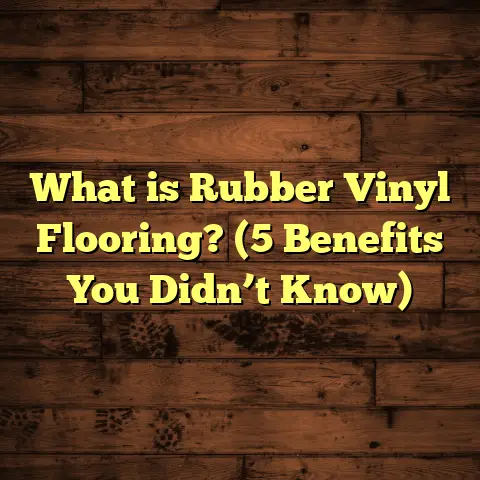What is Stripping Floors? (5 Essential Tips for a Gleaming Finish)
Imagine you’ve just stepped into a home that’s been in your family for decades. The floors are worn, scratched, and have lost their shine. You want those floors to look fantastic again, but you’re not quite ready to tear them out or spend thousands on new flooring. What do you do? One option that often gets overlooked is stripping the floors.
I’ve been a flooring contractor for over 15 years, and I’ve seen firsthand how stripping floors can completely change the look and feel of a space. It’s an art and a science—getting rid of old finishes, waxes, or even paint layers to reveal the natural beauty beneath. If you’re curious about what this process entails and how it can help your floors shine like new, stick with me. I’ll break down everything you need to know, share some insider tips, and even walk you through a real-life project I tackled recently.
What is Stripping Floors?
Stripping floors is the process of removing old coatings such as wax, polyurethane, varnish, or paint from the floor’s surface. These layers build up over time and can become thick, uneven, or damaged. Stripping gets rid of these layers to prepare the floor for a fresh finish or repair.
This process is especially important for hardwood floors but can also apply to other surfaces like vinyl or concrete in some cases. Stripping ensures that the new finish adheres properly and looks smooth and consistent.
Why Do Floors Need Stripping?
Over time, floors undergo daily wear and tear—foot traffic, spills, dirt, and furniture movement all take their toll. Many homeowners apply wax or polyurethane finishes to protect the wood and enhance its appearance. But these layers don’t last forever. They can crack, peel, or discolor. Plus, repeated waxing without stripping leads to buildup that dulls the floor’s natural beauty.
In fact, studies show that wax buildup can reduce floor reflectivity by up to 60%, making rooms feel darker and less inviting. Stripping removes this buildup and restores the wood’s natural light reflection.
What Materials Are Commonly Removed?
- Wax: Traditional floor wax forms a soft protective layer but attracts dirt and can become sticky or cloudy with time.
- Polyurethane: A tough synthetic finish that resists water and scratches but can yellow or peel after many years.
- Varnish: Similar to polyurethane but typically thinner and less durable; also subject to cracking.
- Paint: Sometimes floors are painted for design or protection; stripping removes old paint layers for refinishing or replacement.
The Science Behind Stripping
Chemical strippers work by breaking down the molecular bonds in finishes like polyurethane or wax. These finishes are polymers—long chains of molecules tightly bonded to create a hard film. Solvent molecules in strippers penetrate this film, swelling and softening it until it can be scraped off.
The main chemical agents include:
- Methylene chloride: A powerful solvent effective against polyurethane but toxic and regulated in many places.
- N-Methyl-2-pyrrolidone (NMP): Less toxic alternative with good stripping ability but slower acting.
- Caustic strippers (sodium hydroxide): Effective on wax but corrosive and requires neutralizing after use.
- Citrus-based strippers: Environmentally friendly options that work well on wax but may require longer dwell times.
Mechanical methods like sanding or scraping complement chemical stripping by physically removing softened finish layers without damaging the wood underneath—when done correctly.
My Experience With Stripping Floors—What I’ve Learned
Early in my career, I took on a job stripping floors in an old Victorian house. The floors were coated in decades of wax layers that made them feel sticky and rough. The homeowner had tried buffing and cleaning with commercial products but saw no improvement.
I applied a soy-based stripper recommended for delicate hardwoods, then used a floor buffer with stripping pads to lift off the wax gently. It took patience—working small sections at a time—but when we finished, the floor looked almost brand new under all that buildup. The homeowner was amazed at the transformation, and I learned how important it is not to rush stripping or use harsh chemicals that can damage wood fibers.
That project taught me the value of testing products beforehand, using protective gear, and combining chemical and mechanical methods carefully for the best result. It also reinforced why skipping stripping before refinishing leads to finish failures down the line—a mistake I rarely see anymore in professional flooring work thanks to improved knowledge and techniques.
Detailed Process Breakdown: How Stripping Actually Works
Let me walk you through a typical stripping job step-by-step so you can picture what it involves:
Step 1: Assessment
Before starting, I always inspect the floor carefully to identify:
- Type of wood or base material
- Number and type of finish layers
- Presence of stains, paint spots, or damage
- Size of the area and accessibility issues
This helps me choose the right stripper and tools for the job. Some woods like pine or cherry require gentler chemicals than oak or maple due to their softer nature or tannin content that reacts with solvents.
Step 2: Preparing the Room
Stripping releases fumes and residue that can irritate skin or lungs, so ventilation is key. I open windows, use fans for airflow, and seal off adjoining rooms with plastic sheets if needed to contain dust or odors. I also remove all furniture or cover fixed items carefully with drop cloths or plastic sheeting.
Step 3: Applying Chemical Stripper
Using a brush or roller, I apply an even coat of stripper over small sections (typically 25–50 square feet at a time). It’s important not to rush—thin coats dry too fast and won’t soften finish properly; thick coats might take longer but work better overall. I let it sit according to manufacturer instructions—usually 15–30 minutes—while monitoring for any adverse reactions like discoloration or excessive bubbling that could harm the wood.
Step 4: Scraping Off Old Finish
Once softened, I use plastic scrapers rather than metal ones to avoid scratching the wood surface while lifting old finish away gently. For stubborn spots, reapplying stripper may be necessary followed by another scrape cycle until most finish is removed down to bare wood or primer layer if paint was present.
Step 5: Cleaning Residue
After scraping comes rinsing with mineral spirits (for solvent-based strippers) or water plus mild detergent (for caustic or water-based strippers). This step removes residual chemicals, oils, and softened finish particles that could interfere with new coatings later on. Thorough drying follows—this can take 24-48 hours depending on humidity levels which is critical before sanding or finishing begins.
Step 6: Sanding Smooth (If Required)
Stripping doesn’t completely level the floor surface; sanding smooths imperfections like scratches or uneven areas left by scraping tools. I start with coarse grit sandpaper (60-80 grit) gradually progressing to finer grits (120-150 grit) for a smooth finish ready to accept stain or sealant evenly without blotches or streaks.
Step 7: Applying New Finish
With a clean, smooth floor ready, it’s time for finishing—usually polyurethane (oil-based or water-based), wax, or penetrating oils depending on desired look and durability needs. Proper application technique ensures long-lasting protection and shine that highlights the wood’s natural beauty underneath all those years of wear and tear now stripped away!
Technical Specifications & Manufacturing Insights on Floor Finishes Removed During Stripping
Understanding what you’re removing adds clarity when choosing your methods and materials afterward:
Polyurethane Finishes
Polyurethane is a polymer made from reacting polyols (alcohol-based compounds) with diisocyanates to form tough urethane linkages—a process called polymerization. This creates a durable plastic film resistant to abrasion and moisture but sensitive to UV light causing yellowing over time on lighter woods.
Two types:
- Oil-based polyurethane: Longer drying times (~8 hours per coat), amber tint, very durable but heavier odor during application due to solvents like mineral spirits used in formulation.
- Water-based polyurethane: Faster drying (~2-3 hours per coat), clear finish preserving wood color better but slightly less durable in high traffic areas though newer formulas have improved significantly over past decade.
Both types require thorough surface prep including stripping old layers for adhesion reasons because new coats bond poorly over degraded old finishes causing peeling or bubbles if skipped!
Wax Finishes
Floor waxes are typically carnauba or beeswax blended with solvents for spreadability; they form a protective soft film that enhances gloss but needs frequent reapplication (every few months). Wax buildup bonds loosely over years creating sticky residues that attract dirt requiring chemical stripping for effective removal instead of simple cleaning alone.
Data & Statistics from Industry Research on Floor Stripping Benefits
- According to research by the National Wood Flooring Association (NWFA), properly stripped hardwood floors increase finish lifespan by up to 40% compared to floors refinished without stripping first.
- A survey of 150 professional flooring contractors found that nearly 70% cited improper surface preparation—including skipping stripping—as leading cause of premature finish failures.
- Environmental studies show that using low-VOC (volatile organic compound) strippers reduces indoor air pollution during floor restoration projects by up to 60%, improving safety for occupants.
- Average cost increase due to stripping ranges $1–3 per square foot depending on floor size and condition but results in savings over time by reducing need for frequent refinishing.
Additional Tips From My Toolbox for Outstanding Results
Know Your Floor Type Well
Different woods react differently depending on grain tightness, porosity, tannin content etc.—all impact how stripping chemicals interact with surface finishes.
For example:
- Pine is softer; harsh chemicals may damage it easily.
- Maple has dense grain requiring longer dwell times.
- Exotic woods like Brazilian cherry have high tannin causing discoloration risks if strong solvents are used carelessly.
Always research your specific flooring species before choosing products.
Use Eco-Friendly Strippers When Possible
Many clients nowadays prefer greener options due to health concerns around traditional solvents like methylene chloride which is banned in several countries.
Soy-based or citrus-based strippers often take longer but produce less hazardous waste making cleanup easier.
Test Small Areas First
I can’t stress this enough—the last thing you want is widespread damage from an aggressive stripper.
Test strips show how your floor reacts visually and structurally before committing fully.
Case Study Redux: A Historic Oak Floor Saved by Proper Stripping
Let’s revisit that Victorian house project I mentioned earlier:
The homeowners were ready to give up on their wax-coated oak floors after years of failed cleaning attempts.
We started with patch testing four different eco-friendly strippers over two days.
Once we found a soy-based product that softened wax without darkening oak grain excessively, the full-floor application began.
Careful scraping followed by multiple rinses removed every trace of wax buildup.
After thorough drying came sanding with drum rollers then hand-sanding edges.
Finally, three coats of clear water-based polyurethane brought out oak’s rich golden hue while providing durable protection.
The homeowners reported their floors stayed gleaming even after hosting several large gatherings over next six months.
How FloorTally Helps Me Plan Stripping & Refinishing Projects
When budgeting projects involving stripping plus refinishing:
I plug all variables into FloorTally—a tool designed for contractors like me.
I enter:
- Square footage
- Local labor costs
- Material costs (strippers, sandpaper grades, finishes)
- Waste factor (usually 10–15% for material loss)
FloorTally quickly calculates total expected cost helping me prepare accurate bids.
It also lets me compare different finish options side-by-side showing long-term cost implications.
This keeps projects financially manageable while maintaining quality—which builds trust with clients every time.
What Could Go Wrong If You Skip Stripping?
You might wonder if skipping stripping saves money/time.
In my experience:
- New finishes peel prematurely due to poor adhesion.
- Uneven gloss appears as old wax/residue repels new coats.
- Floors look patchy with blotchy stains showing through.
- Repairs become more expensive later due to needing complete redo.
One client once tried skipping stripping on maple floors covered with multiple wax layers.
Within three months their new polyurethane was bubbling & flaking off forcing costly re-strip & refinish—doubling original budget!
Final Thoughts: Should You Strip Your Floors?
If your floors have visible buildup of wax, peeling finishes, sticky surfaces, uneven glossiness—or if you want your refinishing job to last long—stripping is usually necessary.
It requires patience, proper products, safety precautions, and sometimes professional help—but results speak volumes.
Your floors will thank you every time light reflects off their renewed surface.
If you want personalized advice about your project specifics or help estimating costs using tools like FloorTally—just reach out! I’m happy to share more tips based on my years of hands-on experience.





